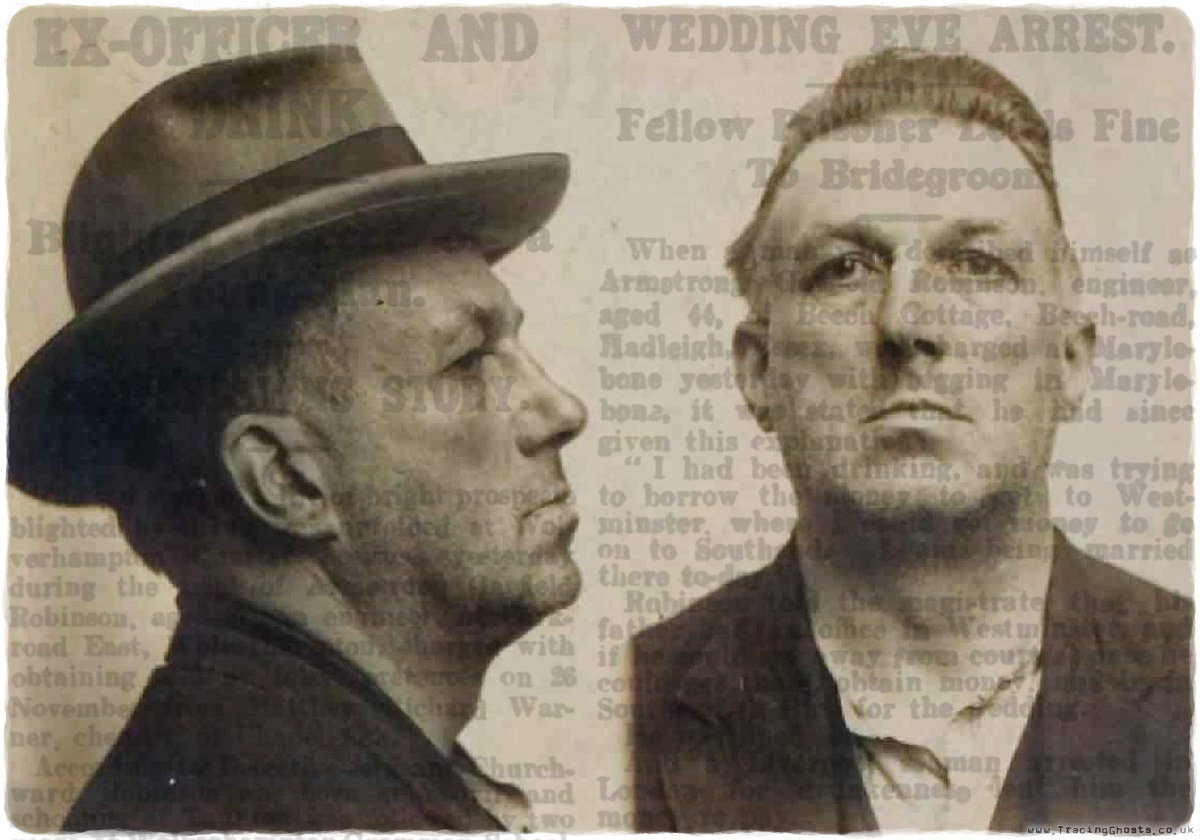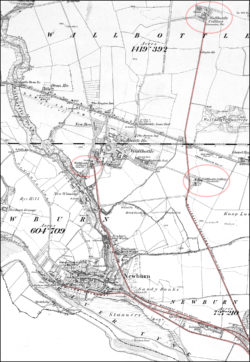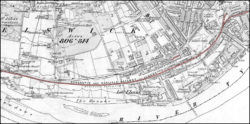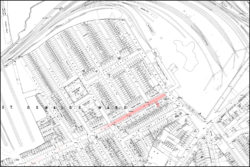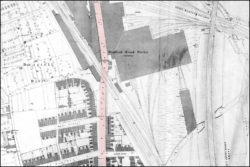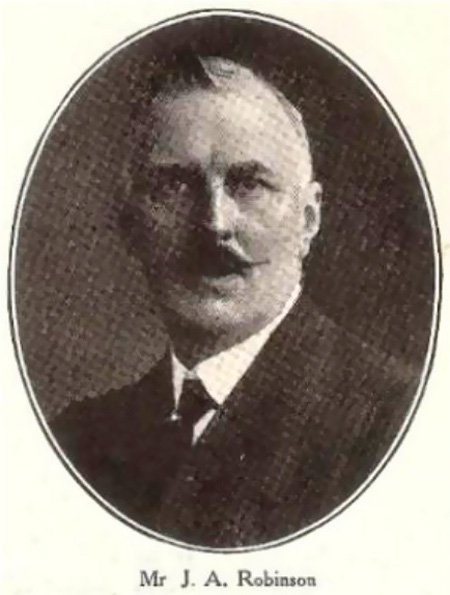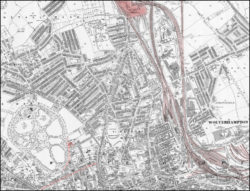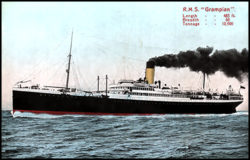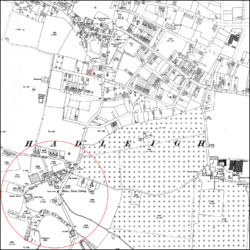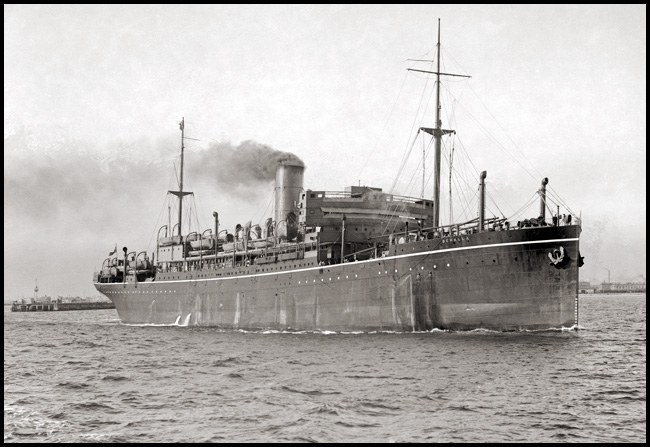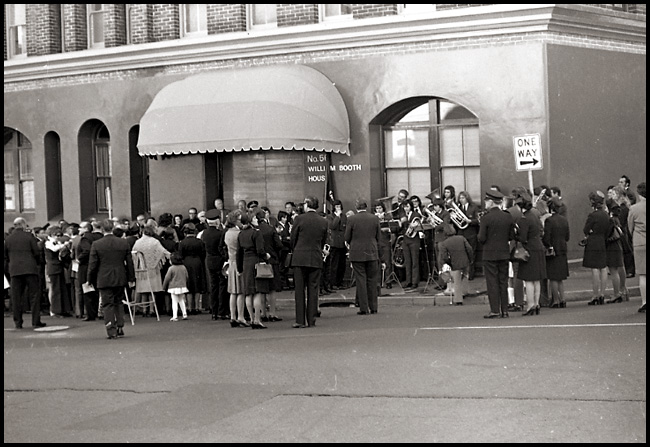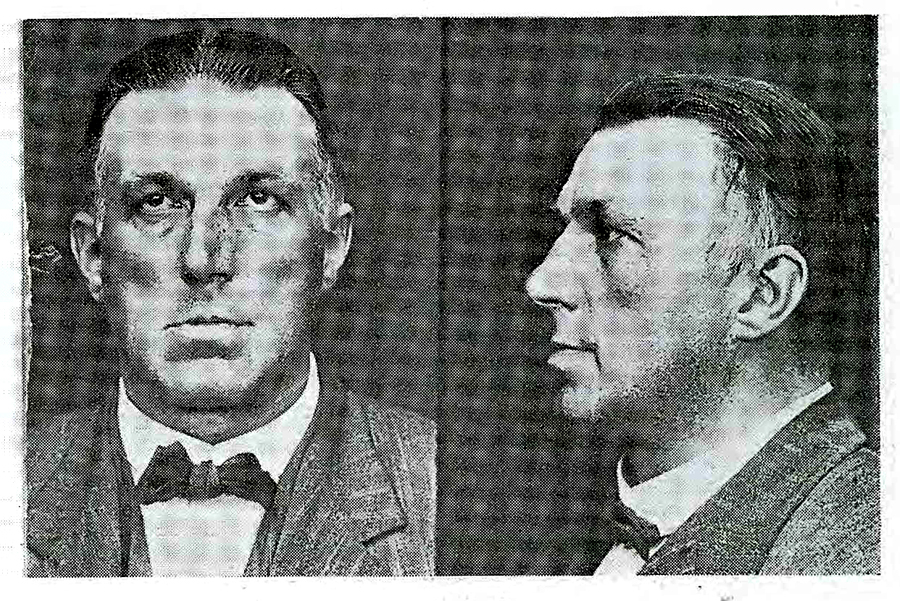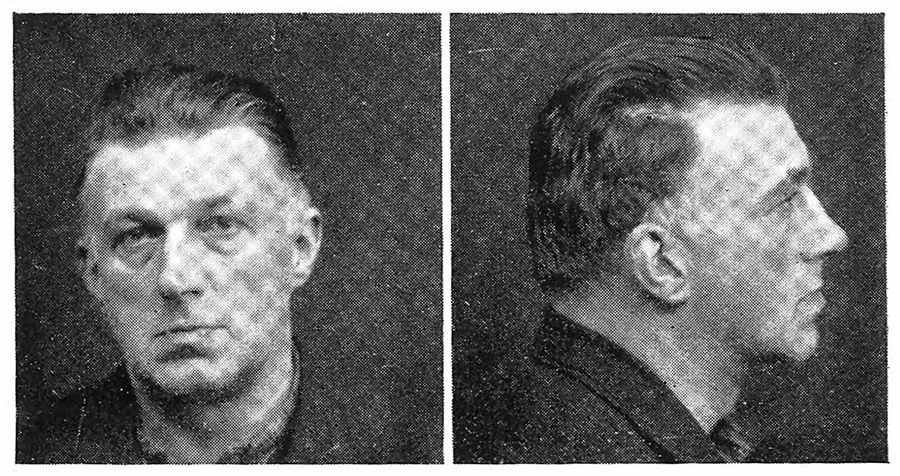From time to time I scan the newspaper archives for mention of interesting historical stories from my hometown of Hadleigh, Essex. February’s search threw up what at first appeared to be an amusing story of a Hadleigh bridegroom’s over-exuberance in London on the eve of his wedding causing him the need to beg for money to get back home.
WEDDING EVE ARREST – Fellow Prisoner Lends Fine To Bridegroom
Armstrong Garfield ROBINSON, age 44, an engineer of Beech Cottage, Beech Road, Hadleigh, Essex was charged with begging at Marylebone, London on 22nd Feb 1924. He told the court “I have been drinking, and was trying to borrow the money to get to Westminster, where I could get money to go to Southend. I am being married there to-day.” He was fined 10 shillings, which was paid for by a Liverpool seaman who had been arrested for drunkenness.
With his excellent name, I began to search for a marriage record, wondering if he had managed to get to Southend on time, but came up empty. At least for a marriage in 1924. What I went on to uncover were three generations of well-respected railway engineers, and a clever man’s life blighted by alcohol and the after-effects of a head injury sustained during WWI.
- Armstrong Garfield Robinson
To understand more about Armstrong, I began by researching the lives and careers of his paternal grandfather and father.
Armstrong’s Paternal Grandparents | Matthew ROBINSON & Jane ARMSTRONG
Matthew ROBINSON was born on 26th Nov 1829 in Walbottle, Northumberland and baptised in nearby Newburn. He was the fifth of at least seven children born to John ROBINSON (1791-1867) and his wife Mary WILKINSON (1792-1848). John was also born in Wallbottle and worked as a coal waggonman for one of the nearby collieries, each of which had waggonways. In 1841 the family was living in Lemington, the next village east of Newburn and where the waggonways converged. Working along the lines were Puffing Billy and Wylam Diffy, the world’s two oldest surviving railway locomotives.
By 1851, Matthew (age 22) was working as an engine driver for the Newcastle & Carlisle Railway and living with his sister Ann and family in Elswick (5 miles east of Newburn and a mile out from Newcastle). The railway line ran just south of the village alongside the River Tyne and the family lived at 7 Carr Street just off Railway Street. Newcastle Central Railway Station had opened the previous year in Aug 1850.
- Wallbottle & Newburn, Northumberland (Sheets XCVI & LXXXVII, Surveyed 1858-1860, Published 1864-1865)
- Elswick, Northumberland (Sheet XCVII, Surveyed 1858, Published 1864)
Matthew’s work took him west along the railway line into Carlisle where he met and married Jane ARMSTRONG (age 34) on 9th Feb 1854. Jane was born in 1820 in Walby, Cumberland to farmer James ARMSTRONG and his wife Margaret IRVING and was employed as a domestic servant in Carlisle for a general practitioner and his family in 1851. Their first child was born the year following their marriage and the family then moved back along the line to Newcastle Upon Tyne where their second child was born in 1856.
Although there is no link between Jane and Joseph ARMSTRONG (1816-1877), the locomotive engineer and 2nd superintendent of the entire Great Western Railway it is likely that the Robinson family knew Joseph’s family who had moved to Newburn in 1824. Matthew was certainly acquainted with Joseph’s younger brother George ARMSTRONG (1822-1901) and in Jun 1857 joined him on the Shrewsbury & Chester Railway (which had merged with Great Western Railway in 1854) moving over 200 miles down-country to Shrewsbury, Shropshire.
The Robinsons did not remain in Shrewsbury long as Matthew’s work soon moved him to Wolverhampton, Staffordshire (along with George ARMSTRONG) where their third and final child was born in 1858.
- James Armstrong Robinson (b.15 Apr 1855 in Carlisle, Cumberland)
- John George Robinson (b.30 Jul 1856 in Newcastle Upon Tyne, Northumberland)
- Jane Eleanor Robinson (b.Apr-Jun 1858 in Wolverhampton, Staffordshire)
The family was living on Lower Stafford Street, Wolverhampton when the 1861 census was taken, most likely in one of the GWR-owned cottages just by the works (map below). On 1st Oct 1869, Matthew began a new position with Great Western Railway in Chester, Cheshire as the foreman of their sheds and shop, moving the family once again to 124 St Anne Street just by the railway. By 1871 Matthew and Jane’s sons were also in the employ of GWR, James (age 15) as an engine fitter apprenticed to his father for the past year, and John (age 14) as a clerk (his apprenticeship would begin the following year). Their daughter Jane (age 12) was at school.
- St Anne Street, Chester, Cheshire (XXXVIII.11.8, Surveyed 1873, Published 1875)
- Stafford Road Works, Wolverhampton, Staffordshire (LXII.6, Surveyed 1886, Published 1886)
The Robinson family took one final move back down the county at the beginning of 1876 when Matthew was promoted to the district superintendent of Great Western Railway in Bristol. His rate of pay on 1st Feb 1876 was £300 (£28.6k as of 2023) rising to £350 on 30th May 1880. The family lived at GWR-owned “Avon Clift House” near Bristol, where the family was present when the 1881 census was taken. Matthew was recorded as age 56, although he was actually 51, and simply described his occupation as “locomotive engine driver“. His wife Jane was 60 and they employed one general domestic servant. Still living at home were their three adult children: James had just turned 26 (recorded as 25) employed as an “engine fitter at works” along with John (age 24). Their daughter Jane (age 22) had no occupation. James married just 23 days after the census was taken to Agnes Emily BLAIR followed by John in 1884 to Mary Ann DALTON (their daughter Jane never married). John joined the Waterford and Limerick Railway in 1884 as their locomotive, carriage and wagon assistant superintendent based in Limerick, Ireland and was promoted the following year to superintendent.
Matthew’s wife Jane died on 27th Mar 1889 aged 68 and was buried at Arnos Vale, Bristol situated just east of their home. Just prior to this on 20th Jun 1887 his wages rose to £400 (£43.5k) and again on 3rd Nov 1890 to £450.
On 2nd Feb 1897 at the age of 67 Matthew resigned his position at GWR after the company brought in new regulations affecting working age. Previously, employees were retired on a fixed pension “dictated solely by considerations of health and strength“, but with a large sum now accumulated in their superannuation fund the company was finally able to offer retirement at the age of 65 with a pension based on individual salaries. Matthew and his daughter Jane moved from their GWR-owned home to the self-named “Newburn Lodge” at 31 Knowle Road, Bristol (continuing to employ a general domestic housemaid).
- Avon Clift House, Bristol, Gloucestershire (LXXVI.1.12, Surveyed 1881-1882, Published 1884)
- Avon Clift House and Newburn Lodge, Bristol, Gloucestershire (LXXVI.1, Revised 1902, Published 1904)
Matthew died at Newburn Lodge on 27th Apr 1904 aged 74 and was buried with his wife at Arnos Vale five days later on 2nd May. He was later described as “as a true north country gentleman standing well over six feet in height, weighing almost 20 stones and complete with huge bushy beard.” By this time his son James was the divisional superintendent for Great Western Railway in Wolverhampton and John was the locomotive and marine engineer for the Great Central Railway Company in Manchester. John went on to design several locomotives and was awarded a CBE in 1920, shortly before retiring in 1922 (James retired in 1920).
Jane continued to live at Newburn Lodge with her lady’s maid (Lucy Mary Cowen) and one general domestic servant. Shortly after the 1921 census, Jane and her lady’s maid moved to 55 Westbury Road, Westbury-on-Trym near Bristol where she renamed her home “Newburn Lodge“. Her lady’s maid Lucy died at Newburn Lodge on Apr 2nd 1925 aged 49 after twenty-five years of service as Janes’s “faithful companion“.
Matthew and Jane’s son James (as detailed below) died on 28th Jul 1932 aged 77 in Wolverhampton followed shortly after their daughter Jane died on 16th Oct aged 74 (who was buried with her parents at Arnos Vale). Their son John retired to Bournemouth, Hampshire where he died on 7th Dec 1943 aged 87.
Armstrong’s Parents | James Armstrong ROBINSON & Agnes Emily BLAIR
James Armstrong ROBINSON was born on 15 Apr 1855 in Carlisle, Cumberland. He was apprenticed to his father Matthew as an engine fitter on 10th Jan 1870 at age 14 in Chester, Cheshire and also worked at Wolverhampton up to 1876. The family moved to Bristol in 1876 where on 16th Apr (having now completed his apprenticeship) he was hired as a fitter for Great Western Railway before moving to Yeovil, Somerset to take up the position of foreman on 6th Apr 1878 where he had sole charge of the sheds.
James married Agnes Emily BLAIR (age 30) on 26th Apr 1881 at St Michael, Bishopston, Gloucestershire. Agne’s father, John BLAIR was a bookseller and optician working in Bristol and her mother Eliza (nee HANCOCKS) was the daughter of a waterman. Agnes was the youngest of seven siblings, all born in Bristol.
Armstrong Garfield ROBINSON, James and Agnes’s first and only child, was born on 22nd Apr 1883 in Yeovil, Somerset and was baptised at St Michael and All Angels, Bishopston, Gloucestershire on 22nd Jul. The family moved to Taunton, Somerset two years later when James’s work changed locations on 2nd Sep 1885 continuing in his position as a foreman engineer. The family lived in Whitehall Villas, Kingston Road directly next to Taunton train station and employed one general domestic servant. During the eight and a half years he was employed at the Taunton section of the Bristol division both trains and staff increased by 20%.
James was appointed as the new Great Western Railway assistant district superintendent for Newton Abbot, Devon in Feb 1894 and the family moved south. James’s wages rose from £200 in May 1894 (£21.5k as of 2023) to £250 in May 1896 and progressed to district superintendent in Jan 1897 with a pay rise to £350 (£37.6k). In Sep 1897 he was promoted to assistant outdoor and divisional superintendent at Wolverhampton, Staffordshire. When James had left Wolverhampton some twenty-two years prior it had been as an apprentice, and on his return, he was also given the role of superintendent of the Stafford Road Works (map below) which employed over 1000 men. His photograph was included in the Great Western Railway Magazine. James was admitted to the Institution of Mechanical Engineers on 27th Apr 1898 and two days prior 15-year-old son Armstrong began a five-year apprenticeship with Great Western Railway in the fittings and trimmings department where he was assigned to Wolverhampton and Swindon stations.
- James Armstrong Robinson (1897 or later)
The family lived a short walk from Wolverhampton train station at 46 Bath Road with one general domestic servant (see map below), where in 1901 James’s occupation was recorded as a “mechanical engineer’s fitter” and 17-year-old son Armstrong’s as “mechanical engineer’s pupil“. James was now earning £500, rising to £600 in Jul 1902 (£61k). James and Agnes moved to a larger 7-roomed house nearby at 43 Park Road East (also marked on map below) after their son Armstrong married in 1905 and James was now earning £800 (just under £78k). His father’s colleague and former superintendent of Wolverhampton George ARMSTONG had lived close by at 10 Park Road East for many years up to his death in 1901.
- Bath Road and Park Road East, Wolverhampton, Staffordshire (LXII.6&7, Revised 1913-1914, Published 1919)
James retired in 1920 when he reached 65, taking up “mechanical loco work” for J. & P. Hill Ordnance Works of Sheffield and died at home on 28th Jul 1932 aged 77, quickly followed by Agnes on 18th Sep aged 81. James’s probate value was £5161 19s and 4d (£298k) and Agnes’s was £3111 3s 10d (£179k).
Armstrong Garfield ROBINSON
Armstrong Garfield ROBINSON was born on 22nd Apr 1883 in Yeovil, Somerset and was the only child of James Armstrong ROBINSON and his wife Agnes Emily BLAIR. Following in his father, uncle and grandfather’s footsteps, Armstrong began a five-year apprenticeship with Great Western Railway on 25th Apr 1898 at the age of 15. His father had taken a new position in Wolverhampton, Staffordshire the previous year and Armstrong was put to work at the Wolverhampton and Swindon depots.
Armstong studied in the Locomotive & Carriage Department as an assistant analyst and tester and was admitted as a student of The Institution of Electrical Engineers in 1902. On completing his GWR apprenticeship on 10th Jun 1903 he resigned and with the aid of a Whitworth Scholarship gained a Bachelor of Science degree at Birmingham University in 1906. During this time he had moved between Middlesex, Wiltshire and Staffordshire with his studies.
Armstrong married Florence Ada Beatrice SHINTON (age 19) on 29th Jul 1905 at the register office in Wellington, Shropshire (25 minutes west of Wolverhampton by train). Florence was the daughter of John SHINTON, a Wolverhampton tinsmith and foreman of the local cycle works, and his wife Jane COTTERILL. Their first child was born the following year in Hadley, Shropshire and their second in Watford, Hertfordshire.
- Joan Agnes Robinson (b.26 Jun 1906)
- Elaine Victoria Robinson (b.02 Mar 1911)
When the 1911 census was taken Armstrong, now a consulting engineer, was living at Highfield, Gammons Lane/Leavesden Road, Watford, Hertfordshire with one servant and a visitor, whilst Florence and their eldest daughter were living with her parents back in Wolverhampton. Their youngest daughter, who was just 4 weeks old at the time, was not recorded anywhere. Armstrong remained at Highfield, Watford until at least 1914 before moving to 1/6 Town Hall Parade, Brixton, London (then Surrey) after war was declared where he was employed as an engineers manager for the Ministry of Munitions.
WWI & AN ENGINEER INCAPABLE AT VICTORIA STREET
Armstrong, age 33, was conscripted in Lambeth on 19th Feb 1916 as a private in the Royal Engineers, Railway Operating Division and placed on the reserve list. His papers described him as 5ft 10½, with a fair complexion, dark hair and eyes and no descriptive marks. It is at this point that Armstrong’s personal life begins to take a public downward turn as on 21st Mar he was arrested by PC Moody for being “drunk and incapable” at Victoria Street, Westminster and charged three days later. He pleaded guilty and was fined 5 shillings. Three months later Armstrong received his notice papers, swiftly replying on 22nd Jul that he was exempt under the Military Service Act, being badged and certified by the Ministry of Munitions to whom he was engaged upon munitions and other government contracts.
CHARGE OF EXPOSING IMPORTANT DOCUMENTS
Armstrong found himself once again in trouble with the law at Wolverhampton Police Court on 11th Aug 1917. Describing himself as a “draughtsman of London“, Armstrong had been drinking heavily. On visiting a local hotel he posed as an inspector from Scotland Yard, and displayed various important documents in his possession. He then called upon the Chief Constable of Wolverhampton, and while awaiting an interview, “produced certain papers, and made use of observations which led to his detention“. Armstrong had no connection whatsoever with Scotland Yard but did know some of the inspectors. In his defence, it was submitted “that the documents got into the prisoner’s hands by inadvertence“. It was also stated that he had been in “good positions, and had travelled considerably on the Continent“. He was charged under the Defence of the Realm Act, a serious crime during the war, and given a fine of £25 (about £1400 as of 2023) or three months’ imprisonment. He paid the fine.
Armstrong’s military records show that he was engaged as a sapper with the Royal Engineers, Railway Operating Division on 31st Aug 1917 with the qualification of “engine driver“. At the time he had been working for a controlled firm at £375 a year (about 16k), steeply dropping to 8 shillings a week with the army. Armstrong was sent to Longmoor Military Camp in Hampshire the following day and stationed at the nearby town of Bordon. His wife and daughters were now living at 43 Park Road East, Wolverhampton with his parents. Just over six weeks later on 16th Oct he was given the temporary commission as 2nd Lieutenant in the Railway Operating Division, immediately discharged from the army and sent to Sheffield, South Yorkshire and Manchester, Lancashire where he was employed as a distribution officer. There were no further entries added to his military records after this date implying the position of 2nd Lieutenant was purely for employment purposes and his time in the army very short.
CONCUSSION & HEATSTROKE
In late 1917 or 1918, Armstrong sustained two serious head injuries after either falling down a flight of stone steps at Basingstoke railway station in Hampshire or during his time in Manchester. The exact date and cause of his injuries are very unclear, only coming to light in two later newspaper reports from 1919. He was left with a concussion which resulted in some brain damage for which he was treated in a “mental hospital for officers” and warned by his doctor about the effects alcohol would now have on him. After the accident, Armstrong was put in charge of market gardens where he ended up suffering from heatstroke, possibly exacerbating his recent concussion.
FOOD BY FALSE PRETENCES
Armstrong moved to Newcastle Upon Tyne, Northumberland in 1919 after gaining the position of assistant superintendent at a local works. On May 14th, after meeting up with some friends and consuming alcohol, he ended up in the Turk’s Head Hotel on Grey Street where he ordered 30 shillings worth of food for which he paid by cheque, knowing he had no money in his account. When arrested on 17th Jul for obtaining food by false pretences he stated he “must have been crazy at the time” and had no recollection of what happened. Armstrong was held in custody until his trial on 29th Jul where he was represented by a local solicitor, Swinburne Gibson WILSON. Mr Wilson detailed Armstrong’s working and military background, as well as his head injury, and went on to state that his friends were “anxious to make full reparation” by paying all expenses “in this and like cases“. His father was understandably concerned about his son and “ready to send him on a long sea voyage” which took place the following year. Armstrong was fined £20 (about £850).
NO TICKET
Just four months after being charged in court for false pretences, Armstrong was back again on 24th Nov 1919, this time at Bournemouth Police Court in Hampshire being charged with fraud on the railway. Armstrong had been travelling between Eastleigh and Bournemouth on the London & South Western Railway without a ticket and whilst under the influence of drink. He informed Inspector J.J. Hibbert “that he was Mr. Warner, of Eastleigh“. William Henry WARNER was a railwayman of similar age to Armstrong who worked on the LSWR and lived in Eastleigh, Hampshire and was presumably an acquaintance of sorts. His previous convictions were not taken into consideration and he was charged 20 shillings, and advised to “give up the drink“.
FORMER SHEFFIELD MANAGER’S DELUSION – POSED AS A SCOTLAND YARD OFFICER
Armstrong’s position of assistant superintendent at a local Newcastle works was not long-lived having moved to York Road, Wolverhampton, Staffordshire by Dec 1919 where found himself in court on two counts of impersonating a policeman whilst drunk. The first event happened in a newsagents shop run by Frank Edwin SAYERS in Hampton Wick on 16th Nov. Armstrong had entered the High Street shop and introduced himself as “Carlin of the Yard“, a well-known Scotland Yard Superintendent of the time (Francis CARLIN, 1871-1930). He stated to be on “special business” and requested a loan of £2, which Mr Sayers gave him. Later, on 29th Nov, Armstrong entered a hairdresser’s shop on the Strand, London and whilst stating to be a detective “for a joke“, asked for a young lady employed there as a manicurist, stating to the proprietor Mr NEWMAN that if she “did not leave the place before the next day she would find herself in trouble“. He then offered Mr Newman a bottle of whisky produced from his pocket before a genuine policeman was found. Armstrong’s solicitor, Mr DAGG, went over his client’s employment, military and medical history, embellishing the truth somewhat to gain a bit more sympathy stating that “in 1915 he gave up a position of £400 a year and obtained a commission in the Royal Engineers.” It also came to light that Armstrong had been offered a £500 a year position (about £21.3k as of 2023) as a locomotive superintendent in Buenos Aires but had lost it due to the court case. The judge gave him another chance “to retrieve his character” and was “remanded on his own bail for three months on his promise to abstain from alcohol“.
THE LONG SEA VOYAGE TO CANADA
True to his father’s word, Armstrong was sent “on a long sea voyage” to Canada leaving Liverpool aboard the Steamship Grampian on 13th Feb 1920 and arriving eleven days later at Saint John, New Brunswick, Canada. The twin-screw SS Grampian, built in 1907, was a two-deck commercial transatlantic ocean liner which during WWI was used to carry Canadian troops. Just seven months before Armstrong’s voyage the ship survived a collision with an iceberg and four months after his return it was gutted by fire whilst being refitted.
Armstrong left his father’s name and address as his nearest relative in the UK rather than that of his wife Florence whom he had now abandoned. His movements over the next seven months are unknown until his arrival at Montréal, Quebec, Canada on 8th Oct 1920 still aboard the SS Grampian. The paperwork stated he was a locomotive engineer and his nearest contact whilst in Canada was Duncan FRASER, a plumber of Watertown, Jefferson County, New York, US. It was during Armstrong’s absence in Canada that Florence applied for a divorce on the grounds of adultery and desertion.
EX-OFFICER AND DRINK – BLIGHTED CAREER OF A YOUNG MAN
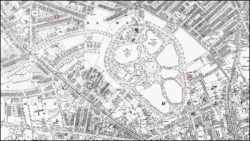
Avondale Road (left) and Park Road East (right), Wolverhampton, Staffordshire (LXII.6&7, Revised 1913-1914, Published 1919)
Armstrong arrived back in England in Nov 1920 and returned to his parent’s home at 43 Park Road East, Wolverhampton, Staffordshire. His estranged wife Florence and their two daughters were living close by at 39 Avondale Road, a large 7-roomed property. No sooner had he returned than he was up to his old tricks again, suggesting he was likely doing the same in Canada. This time Armstrong was charged with obtaining £10 by false pretences on Nov 26th and later impersonating a member of the Royal Irish Constabulary. The cheque Armstrong persuaded local chemist Matthew Richard WARNER to cash was signed “Dudley DOCKER” a former employer of his (Frank Dudley DOCKER was the director of the Metropolitan Amalgamated Railway Carriage and Wagon Company). He later “called at a couple of houses to enquire if there were any firearms on the premises” whilst posing as an officer of the Royal Irish Constabulary.
Once again Armstrong’s background was detailed, this time by Detective Sergeant CHURCHWARD who added “When he is sober, Robinson is a respectable citizen, but in drink he seems to wander aimlessly about not knowing what he is doing“. He was examined by Dr H. SMITH of Birmingham Prison who came to the same diagnosis as previous doctors that there was “a very slight concussion of the brain” and that he would be “very easily overcome by a small quantity of alcohol“. Armstrong’s military career was embellished yet again stating that he had joined the Royal Engineers on the “outbreak of war” and been discharged as a lieutenant, one rank higher.
The court concluded on 7th Jan 1921 and Armstrong was “discharged on entering into his own recognizance in the sum of £100, with one surety of £25, to be of good behaviour and abstain from intoxicating liquor and lead an honest and industrious life, and to appear at any Quarter Sessions for the Borough for judgment, if called upon, during the period ending 29th September 1923, and to enter forthwith the Salvation Army Retreat at Hadleigh, Essex, and remain in such Retreat during the said period, and also during such period to be under the supervision of the Probation Officer of the Petty Sessional Division in which the said Retreat is situate.”
SALVATION ARMY RETREAT, DIVORCE AND MORE FALSE PRETENCES
The Salvation Army had purchased several hundreds of acres of land in Hadleigh in 1891 as part of William Booth’s “Darkest England Scheme“, with it’s aim to help homeless or unemployed men in London gain new skills in agriculture and brickmaking, and ultimately find work. Upon admittance, men agreed to total abstinence from strong alcohol and a separate Inebriate’s Home was opened on site in 1901 in Victoria House (formally Hadleigh House). Victoria House did not last long in its new role as it soon became clear the building was no longer fit for purpose and the men were integrated into the main Farm Colony where Armstong became resident. Shortly after his arrival in Jan 1921, Florence’s petition for divorce was granted (1st Mar) and a small newspaper article headed “Husband’s Habit” stated that Armstrong had “developed a habit of going with other women” and “eventually left her“.
Armstrong was unable to keep himself out of trouble, despite the help he was receiving from the Salvation Army and was back in court on 25th Mar accused of false pretences after attempting to obtain £10 by means of a cheque from George Thomas SAUNDERS, a baker of Vange, Essex whilst presenting himself as a detective from Scotland Yard. He was also accused of obtaining in the same manner 15 shillings from Ernest Victor EVELIN of the Bull Hotel nearby in Pitsea. Armstrong was charged the following month where in his defence his solicitor called on Dr. Ralph NORMAN who said there were “signs that defendant was not normal; his head showed scars of an accident. There were definite signs of neurasthenia, and the symptoms would be aggravated by alcohol“. Armstong’s solicitor, Mr. H. J. JEFFERIES contended that the “defendant, who came from a good family, was, if under any alcoholic influence, quite irresponsible for his actions, and would be unaware afterwards of what he had done“. Armstrong was placed on probation for two years at the Colony and “not to be out without an attendant, and to abstain from alcohol“.
The 1921 census was taken on the night of 1st Jun when Armstrong was recorded at “The Salvation Army Land And Industrial Colony“, aged 38y 2m, divorced and with two children aged 9 and 15. He lived in one of several large dormitories with over 100 other men and his training and skill as an engineer were usefully employed by the Salvation Army during his stay, although he may also have undertaken some manual labour on the farm or brickfields (see map lower down). Armstong’s ex-wife Florence and their two daughters were living at 39 Avondale Road, Wolverhampton, Staffordshire in 1921 and is the last mention of Florence and youngest daughter Elaine to be found in any record.
PRISON FOR PRETENCE
Being placed with an attendant whilst at the Salvation Army retreat must have done some good, as there were no further incidents recorded for well over two years. Armstrong left the Salvation Army’s care on 29th Sep 1923 and gained work at Thames Haven Oil Works near Corringham, Essex. Unfortunately, in Nov he met a couple of friends in Southend and “started on a bout” resulting in him telephoning Mrs CHALLIS landlady of the Railway Hotel, Southend stating to be the Cheif Constable and in need of a £5 cheque to be changed on behalf of a stranded friend. Armstong was once again represented by Mr. H. J. JEFFERIES who told the court how “when in the army he had sustained a concussion of the brain, and at times was not responsible for his actions.” Armstrong pleaded not guilty and “if allowed to return to work, he would abstain from the drink altogether.” With the succession of similar charges now mounting up Armstong was finally given a custodial sentence of three months hard labour, completed in Feb 1924.
ARRESTED ON WEDDING EVE – RUSH TO THE ALTAR – FELLOW PRISONER LENDS FINE TO BRIDEGROOM
Knowing Armstrong’s life up to this point places the newspaper article about the “stranded bridegroom” in a different light. After completing his three-month sentence Armstong returned to Hadleigh and moved into one of the Salvation Army properties called “Beech Cottage” on Beech Road (see map below) but immediately found himself in trouble for begging in East Street, Marylebone, London. He had been drinking and when arrested fabricated a story that he was due to get married in Southend at 2:30 that afternoon but now had no money for the train fair. He had been caught trying to borrow money from strangers, stating that his “father had an office in Westminster, and if he could get away from court at once he could get there, obtain money, and be in Southend in time for the wedding.” His father had retired from the GWR in 1920 and never had an office in Westminster, and there clearly was no marriage planned, but it made for a good story which appeared in newspapers up and down the country. After being fined 10 shillings, which he could not pay, a fellow drunk from Liverpool generously lent him the money.
- “Beech Cottage” Beach Road and Salvation Army Farm Colony in Hadleigh, Essex (New Series 1913, n LXXXII.15 & XC.3 Revised 1919-20, Published 1922-23)
UNIVERSITY MAN’S DOWNFALL – CLEVER ENGINEER WHO TOOK TO DISHONESTY
Barely a week after his fake wedding shenanigans, Armstrong was in court yet again after attempting to obtain money by means of a worthless cheque from Mr STAMP, of the London and North-Eastern Railway Company whilst claiming to be “Commander Holsworthy“. He went on to inform Mr Stamp that “he had been instructed by the general manager to go to Richborough and take two ferry boats to Zeebrugge.” Armstrong’s previous convictions were noted, as was his medical condition, education and military career (he had now “rose from the ranks“). Armstrong’s father James spoke on his son’s behalf and described him as “a very clever engineer” and that “if he had the opportunity he would take his son home and endeavour to get him a position abroad.” The chairman postponed sentence for 12 months stating to Armstrong that “if the position was obtained he need not come up for judgment.” Two months later he emigrated to Australia.
AUSTRALIA – VARIED EXPERIENCES OF AN IMMIGRANT
Armstrong, age 41, boarded the Steamship Benalla at Tilbury, Essex on 8th May 1924 heading for Sydney, New South Wales, Australia where he arrived on 20th Jun. Barely two weeks later he was arrested and fined £3 for evading a taxi fare. Armstrong attempted to obtain work with the City Railway as a mechanical and electrical engineer but only managed to find work as a labourer. He held down the job for five weeks before either leaving or being fired then ended up at the Salvation Army’s recently opened “William Booth Memorial Home” hostel for working men on Albion Street, Sydney.
- Steamship Benalla
- William Booth Memorial Home, Sydney, Australia (1923)
Armstrong’s father sent him various amounts of money to help support his son, ranging from £15 to £50, before leaving for Lithgow, New South Wales where he was offered a £400 per year job at Hoskins Works (iron and steel). However, he swiftly lost it through drink, later admitting it was his own fault, and with no way of supporting himself took to begging and generally making himself a nuisance. He once again represented himself as a policeman and when arrested in Oct 1924 charged with vagrancy said “I have been drunk and I don’t know what I have been doing. I am well known to the Inspector General of Police.” The case was dismissed as the Bench “held that no case had been made out.”
Armstrong was appointed chief mechanical engineer to the Silverton Tramway Company in Feb 1925, a position for which he had applied in Dec. He moved 500 miles west from Lithgow, NSW to Sunshine, Victoria (not far from Melbourne) to a house on Durham Road situated next to the railway station.
SILVERTON TRAMWAY COMPANY LTD.
APPLICATIONS are invited for the POSITION of CHIEF MECHANICAL ENGINEER to the above company.
Applicants must have thorough knowledge and experience in maintenance of locomotive efficiency and running department. They must also be capable of taking charge of the general operations of a railway workshop.
Electrical knowledge and draftsmanship essential.
Salary, £500 per annum, with house, fuel, light, and water.
Applications will be received at the company’s office, Equitable Buildings, Collins Street, Melbourne, until 2 p.m. on Saturday, the 3rd day of January, 1925, and applicants must state at what date they can commence duty if appointed.
By order of the board.
L. H. M. AVERY, Secretary.
Towards the end of 1925 Armstrong married widow Mrs Gertrude RUSHTON (both aged 42) who had only very recently arrived in Melbourne. Gertrude Debora CRUMP was born in late 1883 in Stockton, Shropshire, England, and was the daughter of Edward CRUMP (a joiner) and his wife Jane THOMASSON. She married Walter RUSHTON (a butcher) in 1910 and shortly after headed off to Regina, Saskatchewan, Canada where they had one child together in 1911 (Edward Henry RUSHTON). The family returned to England in Feb 1915, a few months after war was declared, moving back to Shropshire. Walter died on 22nd Oct 1918 in Wellington, Shropshire aged 34 and Gertrude and her son moved in with her parents in Bloxwich, Staffordshire. On 19th Sep 1925 Gertrude and her son Edward departed the Orient Line’s “Oronsay” bound for Melbourne, Victoria, Australia where she shortly after met and married Armstrong.
The couple had been married less than a year when Armstrong was charged on 18th Aug 1926 for having forged and uttered a cheque in Sydney on 24th Jul. Barely two weeks later he was arrested for doing the same thing again after forging a £2 cheque signed “E. E. Lucy” and uttering it to Percy Venice CORSELLIS of Nock & Kirby’s hardware store. Ernest Edward LUCY (1861-1944) was the chief mechanical engineer of the New South Wales Government Railway and had previously worked for the Great Western Railway in Wolverhampton, Staffordshire, England before emigrating to Australia in 1905. He was most likely known to both Armstrong and his father. Armstong was committed for trial at the next quarter sessions (3rd Sep) where he pleaded guilty and was bound over for sentence, to appear if called upon within 12 months. It is highly doubtful that Armstrong was employed by the Silverton Tramway Company by this time and his new marriage was already in trouble.
Armstrong moved from Australia to New Zealand (his wife Gertrude remained in Melbourne) where he was soon after charged with two counts of theft at the Magistrates Court, Wellington on 5th Oct. This time he received a two-month jail sentence (his photograph and fingerprints were taken) but only served one month and was released on 4th Nov. The prisoner discharge sheet described him as 5ft 9¾ with a fresh complexion, brown hair, brown eyes, a medium nose and a strong build. It also added that he had a scar over each eye, on his forehead, on the top of his head and right wrist. Three months later on 7th Feb 1927 Armstrong was in front of the Magistrates Court, Auckland, New Zealand charged with two more counts of theft, four counts of false pretences and one count of obtaining credit by fraud. He was sentenced to make restitution to each and photographed again. One week later he was back in court charged with false pretences and sentenced to “come up if called on and remain in Inebriates’ Home“.
- Armstrong Garfield Robinson (5th Oct 1926)
- Armstrong Garfield Robinson (7th Feb 1927)
LARCENY BY A TRICK
Newspaper reports and criminal records remained quiet for a year until Armstrong was charged on 22nd Feb 1928 in Melbourne, Victoria, Australia with two counts of larceny and imprisoned for four months. He had now begun to use the aliases “Armstrong Angus Robinson,” “Armstrong Garfield Hill” and “Joseph Hill” in his everyday life, and his pretence to be a police officer whilst under the influence of alcohol had also altered to that of his former position as chief engineer of the Silverton Tramway Company. A month after his release from prison Armstong was arrested and sentenced to 14 days for being “idle and disorderly“, then swiftly rearrested and charged as “Joseph HILL” at Adelaide for larceny and false pretences on 20th Jul:
Armstrong Robinson appeared before Mr. E. M. Sabine, P.M., in the Adelaide Police Court yesterday, charged under the name of Joseph Hill, with having on July 2. falsely pretended to John Benson that he was chief engineer of the Silverton Tramway Company, whereby he obtained 5/ with intent to defraud. He pleaded guilty to that charge, and also to another of the larceny by a trick of £1 trom Muriel Spiro, on July 9. Kearney appeared for him. Prosecutor (Sgt. Lenthall) Mr. B. J. The Police said defendant’s correct name was Armstrong Robinson, although he went under the name of Hill. Defendant -It is Armstrong Garfield Robinson.
Sgt. Lenthall said at the Sydney Quarter Sessions on September 3. 1926, defendant was convicted on two charges of forging and uttering, and was bound over to come up for sentence if called upon within 12 months: in Wellington, New Zealand, on October 5 of the same year. he was sentenced to a month each on two charges of larceny, and at the Victorian Petty Sessions on February 22. of this year. he was found guilty of two charges of larceny, and was sentenced to three months and one month imprisonment.
Detective G. Walters, called by Mr. Kearney. said defendant had been drinking heavily.
Mr. Kearney said it was an unfortunate саве, Defendant was well educated, and held a B.Sc. degree. He served in the Engineers in the war. and in 1918 suffered from concussion. As a result he was admitted to a special mental home for officers. Later he came to Australia, and his wife now lived in Melbourne. He had domestic troubles. In Australia he had been mechanical engineer in the Silverton Tramways Company, and had held other good engineering positions. He took to drink to drown his troubles, and when under its influence imagined that he still held those positions. He had an interest in his mother’s estate in England. and could get remittances almost any time he asked for them. In June he received between £30 to £40.
Defendant told the Court that since he had suffered concussion his will power had deteriorated, and he was affected by drink. He had held good positions in electrical concerns in Melbourne and Sydney, and he could get an appointment at Port Kembla now.
Mr. Sabine said the evidence showed defendant to have been possessed by a well-ordered mind when the offences were committed, for the stories he told were well-conceived. In the second case he picked his man, a foreigner, in ordering a dinner at a cafe. The fact was that he was “hard up” for money for drink when the offences were committed. However, the amounts he obtained were small. Defendant told such strange stories that he did not know when to believe him.
Defendant said he would make an earnest attempt to give up drink.
He was sentenced to two months’ imprisonment for the larceny by a trick, one month for false pretences, 14 days for having been idle and disorderly, and seven days for having been drunk all the sentences to be concurrent.
Armstong was sentenced to three months and twenty-one days in prison but released two months later during the week ending 22nd Sep. He immediately got back in trouble and charged with false pretences on Samuel THOMPSON (14 days) on Sep 22nd. Armstrong was released during the week ending 6th Oct with the description of being 5ft 9½, of stout build and dark complexion, grey hair, brown eyes, an injured nose, ordinary mouth, broad chin, scar left side of the forehead and right wrist, a birthmark on the back of his shoulder, and a scar on the back of his left thigh. No mentions were made this time of the scars on his face or head.
- Armstrong Garfield Robinson, alias Joseph Hill (Sep 1928)
ALLEGED FALSE PRETENCES – ENGINEER COMMITTED FOR TRIAL
Only days later on Oct 8th 1928, Armstrong tried the same con again and attempted to obtain equipment worth £267 from Joseph Edgar BENNET, manager of the Premier Machinery Company. He introduced himself as A. G. Robinson, chief mechanical engineer of the Silverton Tramway Company, and had authority to order certain machinery. He was shown “various articles of machinery, and selected a gas engine and pulleys and an electric lighting set” for which he created an order to be delivered to Cockburn before being taken to the premises of Brown Bros. where he selected other machinery to the value of £50. Whilst at the Premier Machinery Company, Armstrong stole a show medal worth 30 shillings (about £80 as of 2023) and was sentenced to one-month imprisonment.
LAPSE OF EDUCATED MAN – PRISONER SENTENCED AGAIN
After his release from prison, Armstong made his way south to Coburg, Victoria (a little over 450 miles) where on 27th Apr 1929 he yet again used valueless cheques to obtain money. Three days later he was arrested and on questioning said: “I may have put the cheques over – I was drunk at the time.” Armstong appeared in court on 10th May and was committed to trial five days later where he was charged with two counts of false pretences. Due to his ever-increasing list of offences, he was sentenced to six months hard labour on each charge and sent to Pentridge Prison, Coburg.
“Armstrong Garfield Robinson, age 43 years, an engineer, living in Sydney Road, Brunswick, was presented on two charges of having obtained money by means of valueless cheques. He pleaded guilty, and admitted eight previous convictions in different Australian states and in New Zealand. Mr Justince Wasley – I have read your statement, and there are aggravating aspects in connection with your crime. You have professional qualifications, and have held good billets. You have received no substantial sentence so far. The most severe sentence imposed upon you was three months. You will be sentenced to six months imprisonment on each charge, the sentence to be concurrent.”
Armstrong was released on 14th Oct 1929 having served half of his twelve-month sentence. No more criminal records or newspaper reports have been found after this so it is possible he was able to get his drinking under control and stay out of trouble. Electoral records for 1931 list Armstong (“engineer“) and his wife Gertrude (“hosiery worker“) living together at 33 Royal Cresent, Brunswick, Victoria, Australia. Her son Edward Henry RUSHTON (age 19/20) also lived with them and was working as a grocer.
Armstrong’s father James died on 28th Jul 1932 followed by his mother Agnes just under two months later on 18th Sep. His mother left her estate in equal parts to Armstrong and his eldest daughter Joan who was living in Walsall, Staffordshire, England at the time. Despite an address, Joan has been just as impossible to track down as her sister and mother. All proceeds from Agnes’s estate were to be put in trust; half going to her granddaughter Joan with the resulting income paid to her during her life “without power of anticipation“, and her son Armstrong’s income was to be paid in equal quarterly instalments then after his death be added to Joan’s trust fund. No mention was made of Armstrong’s youngest daughter Elaine.
It is unknown whether Armstong returned to England after the death of his parents but none of the family of three are listed in the 1933 electoral rolls in Victoria (possibly untranscribed) and only Gertrude and her son were recorded in 1934 (living at 45 Vauxhall Street, Northcote, Victoria). They do not show up in 1935 then all three were listed in 1936 living at 8 Bluff Avenue, Elsternwick, Victoria. Armstong was now calling himself “Angus Robinson” and working as a surveyor. By 1937 Armstong (as “Angus“) and Gertrude had moved to 12 Pine Avenue, Elsternwick and her son had moved out. Gertrude’s son was listed as “Edward Henry Rushton-Robinson” up to 1940 when he married Florence Melba BREWER, then dropped the “Robinson” from his name. Armstrong and Gertrude had moved again by 1943 to 5a Osborne Street, South Yarra, Victoria where they remained for the next eleven years. Armstrong was now calling himself “Armstrong Angus Robinson” and was employed once again as an engineer.
Armstrong died at Alfred Hospital, Melbourne, Victoria, Australia on 30th Jan 1954 aged 70 and was buried on 2nd Feb at Springvale Crematorium, Springvale, Victoria (under his given name). His death notice stated: “On Jan 30, Captain Armstrong Garfield Robinson, B.Sc., Whit, Sch. Beloved husband of Gertrude Deborah.“. When did Armstrong become a “Captain” or was this another one of his military embellishments? Gertrude moved around Victoria until her death twenty years later on 9th Feb 1974 in Heidelberg, Victoria, Australia aged 90 and her son Edward died in 1999 aged 87.
RESOURCES & REFERENCES
I use many different resources during my research, a majority of which I do online. For this project, I used:
- Ancestry – www.ancestry.com
- British Newspaper Archive – www.britishnewspaperarchive.co.uk (also available on Find My Past)
- Find My Past – www.findmypast.co.uk
- Friends of Vintage Trains – https://friendsofvt.org.uk
- National Library of Scotland (maps) – maps.nls.uk
- Steam Index – https://steamindex.com
- Trove – https://trove.nla.gov.au
- Wolverhampton History & Heritage – www.historywebsite.co.uk
Newspaper articles reproduced with the permission of the British Newspaper Archive and The British Library Board. Maps reproduced with the permission of the National Library of Scotland.
If you have any questions regarding my research or would like anything added or amended, please contact me. I would love to know what happened to Armstrong after his spell in prison in 1929. Did he remain sober and out of trouble? And what happened to his first wife and their two daughters?
I’m available to hire to trace family trees and delve into the history of your house.

